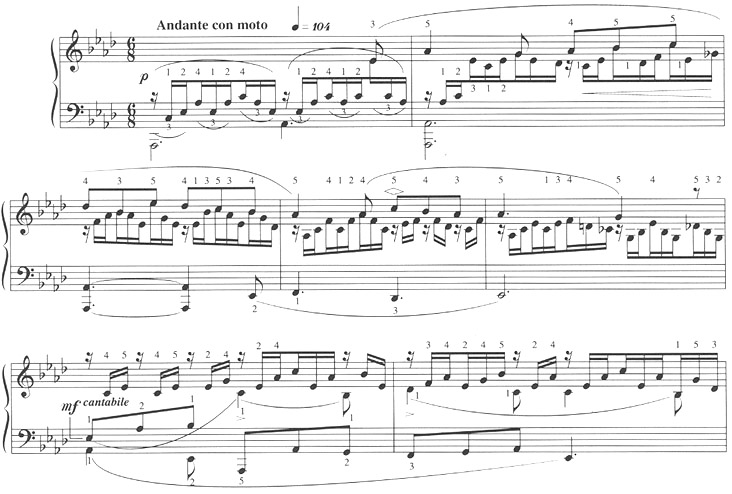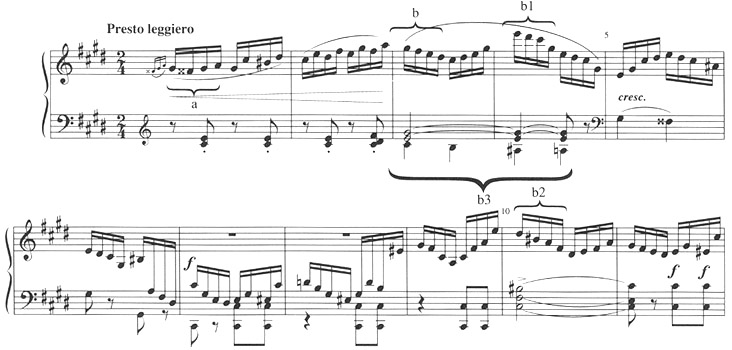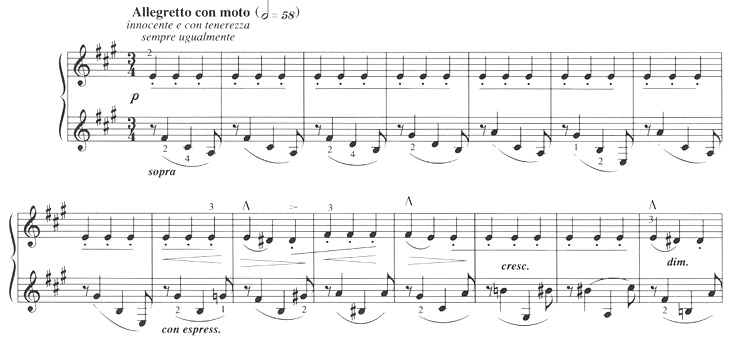This article will examine five piano works from an epoch which has been called the high noon of German Romanticism. Four out of the five works are virtually forgotten today, submerged in the current of the present age. The composers represented, Felix Mendelssohn (1809-47), William Sterndale Bennett (1816-75), Stephen Heller (1814-88), and Clara Wieck (1819-96), were perhaps the musical personalities closest to Schumann during his ten-year tenure as editor of his journal the Neue Zeitschrift für Musik. These composers could have been charter members of the Davidsbündler had Schumann's literary conceit existed in reality. The purpose of focusing on these works is twofold: first, they epitomize the type of music which was the very first to be begrudgingly identified as "romantic," and second, each represent a different ideal of the Davidsbündler ethic. The article will address each of the four composers close to Schumann, beginning with Mendelssohn and proceeding to Bennett, Heller, and Wieck. The discussion of each composer will, in turn, 1) briefly review his or her relationship to Schumann, and Schumann's critical opinion of the composer, 2) analyze salient compositional features of a selected work by the composer, and 3) interpret the piece as a model for a specific Davidsbund ideal.
As a way of fighting what Schumann considered the prevailing musical reactionaries of the day, he created a Davidsbund, a league of David, in which the members of the society were "Davids" fighting with tonal slings and stones the great Philistine army of music conservatives. His society was to be found only in his articles, and he cloaked his own authorship with pseudonyms like Florestan, Eusebius, and Master Raro. Since no journal existed for these articles, Schumann created one: the Neue Zeitschrift für Musik. Schumann's journal first appeared in 1835, with one of its primary goals being the promotion of higher standards in piano music—standards adhering to principles formulated by Schumann. Among these principles were 1) the composer's responsibility to create new forms based on a solid knowledge of older, "classical" models, 2) subordination of technique and virtuosity to the compositional idea, and 3) compositional egocentricity—for music, to communicate at its deepest level, must convey a composer's personal life experience. It was the task of the Neue Zeitschrift to champion new piano music that contained these principles. In Schumann's opinion, the Davidsbund composer's antithesis was the Parisian salon pianist. Henri Herz (1803-88) and Franz Hunten (1793-1878) were particularly offensive to Schumann. To the young unknown Davidsbund artist the Parisian salon music was vacuous and, for Schumann, unfortunately popular. The term "romantic," used first with contempt by writers, reluctantly became for Schumann a euphemism for this younger generation of composers whose music he admired. Their primary medium was the piano, and not surprisingly, Schumann writings concentrated on criticism and problems of piano music and piano playing. As Leon Plantinga states in Schumann as Critic, "composers were heroes or villains according to what they did or did not do at the piano," and the contemporary music of most interest to Schumann prior to 1840 were short piano pieces.1 For Schumann, short works were intended to prepare the way for larger forms such as symphony and concerto.
Turning now to the consideration of the previously mentioned Davidsbund composers, it is appropriate to begin with Felix Mendelssohn, who, as early as 1834, had impressed Schumann, for he had achieved success in the larger forms, and yet continued to produce short works for piano solo.
Mendelssohn arrived in Leipzig in 1835, already a prominent name to the music world at age twenty-five. Though Schumann and Mendelssohn formed a sincere friendship they were never on equal footing as far as professional status: Mendelssohn had, after all, a wide reputation, and Schumann was still an unknown. In any case, friendship did not seem to alter Schumann's objectivity in critical writings on Mendelssohn's music.
In an 1837 review of Mendelssohn's newest piano work, the third set of Lieder ohne Wörte Op. 38, Schumann warned his readers about the problems inherent in stylistically complacent music. However, Mendelssohn avoided the charge of compositional stagnation because of his experimentation within this genre. The last work of this set shows this continued growth. Schumann, in his review, favorably commented that the sixth is not a solo song, but rather a duet.2 The opening (See Example 1) clearly illustrates the nature of the "Duetto."

The first measure introduces the persistent sixteenth-note accompanimental figure that runs throughout the entire work. The bass voice, providing only harmonic support through mm. 1-5, engages in a more active melodic role as the work progresses. The interplay between the soprano, in mm. 2-5, and the tenor, beginning in m. 6, establishes a pattern which continues until m. 30.
The soprano and tenor eventually overlap, and join together for an effective climax. In the codetta the accompanimental sixteenth-note figure is seamlessly reinterpreted as an important melodic idea, and Mendelssohn creates a rich polyphony as all four voices, each an independent voice, sum up and close the work.
The novel melodic treatment of this work, evocative of an operatic idiom, convinced Schumann that here Mendelssohn illustrated the Davidsbund principle of the creation of new forms. The composer's responsibility to evolve, to find new ways of using tried and true formulas and formal designs in the smaller scale piano works is a tenet which recurs in Schumann's writings of this period.3
The only other composer within this article to have written orchestral music by the 1830s is William Sterndale Bennett, the English pianist. Bennett came to Leipzig in 1835 on Mendelssohn's invitation. After his arrival, Bennett became a much closer friend to Schumann than to Mendelssohn. Their shared status as obscure, aspiring musicians may have contributed to this bond. It was in reference to Bennett that Schumann proclaimed his most important duty as critic was to "promote those younger talents, the best of whom are called 'romantics.'"4
Schumann admired Bennett's music and considered it to be of the same caliber as Mendelssohn's. In 1837 he remarked that Mendelssohn and Bennett shared the "same beauty of form, poetic depth yet cleverness, and ideal purity; the same outwardly satisfying impression, but with a difference."5 Five years later, when Bennett brought out Suite de piéces, Op. 24, Schumann continued this comparison:
Resemblances are common between different masters of the same epoch. In Bach, Handel, in Haydn, Mozart and Beethoven in his earlier period, we find a similar aim—But this inclination of one noble mind to another should never be misnamed imitation, and Bennett's likeness to Mendelssohn is involuntary. Yet Bennett's works have continued to increase in originality.6
The "Presto" is a well constructed work, using two motives to create practically all of the thematic material. The motives are bracketed in Example 2 and are as follows: motive a, the turn figure found in m. 1, and motive b, a descending four-note pattern first encountered as a diatonic scale segment in m. 3. The descending group in m. 4 can be seen as a variant of the descending scale, opening up the scale pattern by way of a descending fourth between the last note pairs. A further expansion results in an arpeggio, as in m. 10. The bulk of accompanying material is derived from motive b, as in the descent of the bass in mm. 3-5. Such tight-knit motivic play, coupled with surprising harmonic combinations, give this work the originality that Schumann noted.
Example 2.

The compositional affinity between Bennett and Mendelssohn may be explained in part by the similar classical training each received as a child, instilling in each a reverence for music of the late eighteenth century and even the Baroque period. This homage to older music emerges in Bennett's choice of title for his Op. 24—a suite. In the 1830s the suite was regarded as an antiquated keyboard genre. Bennett's choice of title may well have impressed Schumann, who understood as well as anyone of this time the value of the preceding century's music heritage. The Davidsbund ethic exemplified by the "Presto" is the natural progression of contemporary music as part of the evolution of "classical" values.
Turning now to Stephen Heller, two important biographical details set him apart from any of the other composers. First, he was a regular contributor to Schumann's journal and, second, he never met Schumann, but through extensive correspondence a close affinity developed. Born in Budapest in 1813, Heller quickly blossomed into a superb pianist and by the 1820s had begun to compose. His association with Schumann began in 1836, when he submitted some of his early compositions for Schumann's journal. From the beginning both seemed to share many of the same interests, such as their mutual love for the works of Jean Paul (J. P. F. Richter). In 1836 Schumann invited Heller to become the Augsburg correspondent for the Neue Zeitschrift and in 1838, when Heller moved to Paris, he continued as the Parisian correspondent. His pseudonym "Jeanquirit" (meaning Jean with humor) suited his writing style, as this 1837 entry, from a review of a piano recital, shows. He writes:
(We were shown what) a pianist should not be . . .. With the help of limited study and with constant use of pedals (Feracci) drew from the piano wonderful, never suspected harmonies.7
Schumann not only thought of Heller as a fine critic and fellow soulmate as far as literary and music concerns, but enthusiastically embraced his compositions, as this Florestan review reveals:
I am tired of the word "Romanticist," though I have perhaps not pronounced it ten times in my life; and yet if I wished briefly to characterize our young seer, that is what I should entitle him. . .. He generally expresses himself clearly and cleverly. There is, in the background of his compositions, a peculiar, attractive twilight, or rather dawn, that places his otherwise clear forms in a strange light.8
Of Heller's early compositions his etudes, more than any other of his works, helped first establish his reputation as a composer. His L' art de phraser, Op. 16, one of these collections of early, short piano pieces, deal with various technical problems. "Eglogue," No.8 of the set, is a study for overlapping hands (the opening is found in Example 3).
Example 3.

The clarity Schumann ascribes Heller's work is evident in the ABA' formal design, delineated by contrasting material. That which Schumann states "places (Heller's) otherwise clear forms in a strange light" may be attributed, in this work, to two distinct compositional processes: 1) motivic transformation and 2) metrical ambiguity. At m. 9, marked "con espressivo," the ascending soprano in the left hand emerges out of the chordal texture. The  1 in m. 9 reaches its goal tone, the
1 in m. 9 reaches its goal tone, the  2 in m. 14. The span of a fourth is a unifying factor as different manifestations of this line recur.
2 in m. 14. The span of a fourth is a unifying factor as different manifestations of this line recur.
Metrical ambiguity occurs in two different patterns, and helps to clearly delineate sections. In section A, syncopation permeates the melodic segments. This syncopation, highlighted in Example 4, disrupts the listener's perception of the natural metrical structure.
Example 4.

The effect of this rhythmic device can be compared to a ghost image on a video screen, which is perceived as the same image, but slightly displaced. In section B metrical ambiguity is created by the simultaneous use of two independent metrical units—simple triple time in the right hand over a compound duple time in the left hand (shown in Example 5b).
Example 5a.


This rhythmic device, combined with the textural change in the voicing, vividly contrasts with the outer sections.9 Though unpretentious by design, its motivic connection and metrical subtlety make the "Eglogue" a fine example of a Davidsbund ideal, for it, and Bennett's "Presto" as well, are works in which technique and virtuosity are subordinated to the compositional idea.
Clara Wieck, the last of the composers to be discussed in this article, was most active as a composer between 1830 and 1845. As is well known, the five-year span of 1835-1840 was a period of troubled courtship between Schumann and Wieck. Their relationship, vehemently opposed by Wieck's father, was by necessity a clandestine affair. By 1838 Wieck, then 18 years old, was forbidden to see or communicate with Schumann. Of course, communication took place, both through correspondence and music composition. Davidsbündlertänze, one of Schumann's most overtly personal works, is a conspicuous musical communication to Wieck through motivic and tonal analogy. Wieck communicated to Schumann as well, though not with musical ciphers. Her manner of expression can be heard in "Romance No.2" from Trois Romances pour le piano, Op. 11, composed in Paris in 1839 (the opening is shown in Example 6).

Later that year it appeared in a supplement to the Neue Zeitschrift under the title "Andante und Allegro." Wieck sent Schumann the manuscript for criticism. In an accompanying letter she states that she was thinking of Schumann continually throughout its creation, and gives him suggestions for interpreting it at the piano, writing, "you must play it very freely—at times passionately and then again in a melancholy way."10 Even without this explicit instruction by the composer the music reveals itself by way of its construction. The title "Romance," as well as the tempo marking of "allegro passionato" which begins the second part, help define the evocative nature of the work.
When aware of the personal history behind its conception, the "Romance" illustrates a Davidsbund ideal—musical communication of the life experience of the composer. This work was highly praised by Schumann. He heard its message, and in a letter to Wieck says:
You complete me as a composer just as I do you. Each of your thoughts comes from my soul. . .. There is nothing to change in the "Romance;" it must remain exactly as it is.11
The preceding representative pieces of the composers who could be called the "real" Davidsbündler display the qualities which define for Schumann worthwhile piano music. The years from 1837 to 1841 are particularly prolific for piano music. In these works Davidsbund principles such as the composers' commitment to create new works within an established medium, the subordination of technique and virtuosity to the compositional idea, and compositional egocentricity are all manifest. All of the cited composers attempted to sustain and reflect in their music subjective values they revered from earlier music—that which Schumann called classical ideals.
Reviewing this largely forgotten music underscores the transient lives of much praiseworthy music. For Schumann, whose reputation as music critic preceded his success as composer, Mendelssohn, Bennett, Heller, and Wieck were part of the small group that understood and appreciated his music. Each affected his life in a way that contributed to his creativity, just as his critical commentary no doubt contributed to theirs. Though Schumann considered the music of these composers in every way as exciting as his own, it is his piano music, more than that of any others, which is heard today. Posterity's rigorous selection process requires that music transcend its own time. For us, most of Schumann's music transcends, but most of the music of his own Davidsbund does not.
It seems fitting to close with a quote from Schumann's forward for the complete edition of his collected articles published from 1834-1844. Schumann refers to his imaginary Davidsbündler, but his words could easily apply to the music of the "real" Davidsbündler. He says:
Here I must mention another society, a more than secret one, since it never existed anywhere save in the imagination of its founder: that of the Davidsbündler. Like a scarlet thread this society of Davidsbündler ran through the entire journal, mingling "Truth" and "Poetry" in humorous fashion. The public enjoyed these likable fellows; but afterward they disappeared from the journal's pages . . . . Should these collected pages, the mirrors of an eventful epoch, draw attention to certain musical events which otherwise might be submerged in the current of the present age, the purpose of their editor will have been thoroughly achieved.12
Notes
1Leon B. Plantinga, Schumann as Critic (New Haven: Yale University Press, 1967), 180-81.
2Plantinga, 263.
3Schumann's early piano cycles, Papillons, Carnaval, and Davidsbündlertänze epitomize the idea of experimentation within a specific genre. For an in-depth discussion of large-scale relationships within these piano cycles see Peter Kaminsky, "Principles of Formal Structure in Schumann's Early Piano Cycles," Music Theory Spectrum 11/2, Fall 1989: 207-25.
4Plantinga, 219.
5J. R. Sterndale Bennett, The Life of William Sterndale Bennett (London: Cambridge University Press, 1907), 129.
6Bennett, 129.
7R. Booth, The Life and Music of Stephen Heller (unpublished dissertation, University of Iowa, 1967), 22.
8Booth, 17.
9Schumann certainly enjoyed metrical obfuscation. His Davidsbündlertänze No.4 shares the same type of syncopation as Heller's "Eglogue."
10Nancy B. Reich, Clara Schumann: The Artist and the Woman (Ithaca: Cornell University Press, 1985), 242.
11Reich, 242.
12Robert Schumann on Music and Musicians, ed. Konrad Wolff, tr. Paul Rosenfeld, (Berkeley: University of California Press, 1946), 26.


